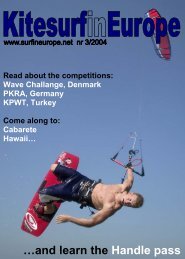Boards 2004 Trip to Isla de Coche New world speed record ...
Boards 2004 Trip to Isla de Coche New world speed record ...
Boards 2004 Trip to Isla de Coche New world speed record ...
- No tags were found...
You also want an ePaper? Increase the reach of your titles
YUMPU automatically turns print PDFs into web optimized ePapers that Google loves.
<strong>Boards</strong> <strong>2004</strong>Text: Jonas HörnsteinThe kite may be the most important part of your equipment, but the significance of the boardshould not be un<strong>de</strong>rrated. In<strong>de</strong>ed it’s the kite that gives you the power and <strong>to</strong> a great <strong>de</strong>al<strong>de</strong>termines how fast you can get upwind and how high you’ll be able <strong>to</strong> jump, but most of thetime you won’t even think about its presence. The board on the other hand has a more directpresence and more directly contributes <strong>to</strong> the overall feeling of the ri<strong>de</strong>. Here we try <strong>to</strong> gui<strong>de</strong> youthrough the enormous variety of boards on the market so you can find the board that gives youexactly the feeling you’re after.Classification of the boardsTo <strong>de</strong>scribe every board on themarket in <strong>de</strong>tail is more or lessimpossible. Instead we have <strong>to</strong>generalise and try <strong>to</strong> group theboards in<strong>to</strong> various categories.Traditionally the boards havebeen divi<strong>de</strong>d in<strong>to</strong> three differentclasses: directional, twin tip, andmutants. Directionals are<strong>de</strong>signed <strong>to</strong> be rid<strong>de</strong>n in onedirection and hence have a frontand a back. The twin tips are<strong>to</strong>tally symmetrical and worksequally well in both directions,which means that you don’tneed <strong>to</strong> turn the board when youwant <strong>to</strong> go in the oppositedirection. A mutant can be seenas a mixture of the two previoustypes as they work in bothdirections but have onepreferred direction. While theclassification of the boards in<strong>to</strong>directionals, twin tips, andmutants, give interestinginformation about their <strong>de</strong>sign itisn’t enough for a potentialbuyer. Ninety percent of theboards on the market could beclassified as a twin tip eventhough there are hugedifferences between them. Analternative way <strong>to</strong> classify theboards would be <strong>to</strong> classifythem according <strong>to</strong> their range ofuses. Is the board <strong>de</strong>signed <strong>to</strong>be used on flat water, in choppyconditions, or in breakingwaves? Should it be used instrong or light wind conditions?Is it <strong>de</strong>signed with beginners orpro-ri<strong>de</strong>rs in mind? However, <strong>to</strong>cover all combinations of thesevariables one would need lots ofdifferent classes that would alsobe overlapping. It would simplifyfor the buyers if industry wouldagree on a few different classesin which the boards could bearranged. Today there are nosuch classes. Instead theboards are <strong>de</strong>scribed byparameters such as length,width, weight, stiffness, outline,and rocker. For those who arefamiliar with the terminology andthe mysteries of board <strong>de</strong>signthese parameters give veryaccurate information on how theboard will feel in the water. Forthe rest of us it gets more orless a pure guessing game. Inor<strong>de</strong>r <strong>to</strong> improve the odds offinding the right board we give ashort introduction <strong>to</strong> how thedifferent parameters affect theboard’s behaviour on the water.Finally we exemplify how theseparameters can be combined inor<strong>de</strong>r <strong>to</strong> create boards forspecific types of usage.Length and widthWe start with the most obviousparameters, length and width.The more wet surface un<strong>de</strong>r theboard, the earlier the boardstarts <strong>to</strong> plane. Beginners andheavier ri<strong>de</strong>rs need a little bitmore area than light weight,experienced ri<strong>de</strong>rs in or<strong>de</strong>r <strong>to</strong>get going and be able <strong>to</strong> goupwind. To get a larger surfaceun<strong>de</strong>r the board we canobviously choose <strong>to</strong> increaseeither the length or the width.What we choose has a biginfluence on the characteristicsof the board.8A long and narrow board gives asmoother and more controlledri<strong>de</strong>. It is easier <strong>to</strong> get a lot ofrail in the water <strong>to</strong> get upwindand the board doesn’t bounceout of the water as easy whenthe water is choppy. On theother hand that bounciness maybe <strong>de</strong>sire as it gives you a goodlift when you kick the board ou<strong>to</strong>f the water. Such a board isoften said <strong>to</strong> have a good “pop”.In short you can say that for acertain surface area, the shorterthe board is the more pop it willgive you, but it will also be moreunsteady in the water. It cantherefore be an i<strong>de</strong>a <strong>to</strong> firstconsi<strong>de</strong>r the kind of conditionsyou will use the board in and ifyou first of all want acomfortable board that givesyou a good grip in the water or aboard with more pop. From thatyou can get an i<strong>de</strong>a of whatcould be a good length of yourboard. If you primarily use theboard in flat-water conditionsand like <strong>to</strong> pull off the latestwakeboard tricks, a short boardlike 120 cm or even less couldbe good for you. If you, on theother hand, usually ri<strong>de</strong> inchoppy conditions and like <strong>to</strong> beable <strong>to</strong> dig down the rail andpush hard in the turns withoutworrying of the board loosing itsgrip, a board of at least 130 cmcould be better for you. Thewidth is then <strong>de</strong>termined by howmuch you weight and in howstrong winds you will use theboard. The heavier person andthe lighter wind, the wi<strong>de</strong>r aboard will be nee<strong>de</strong>d.





